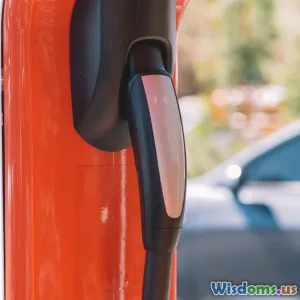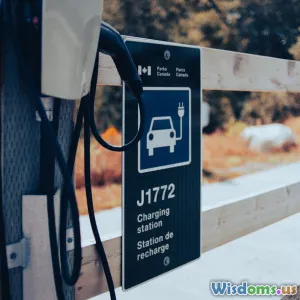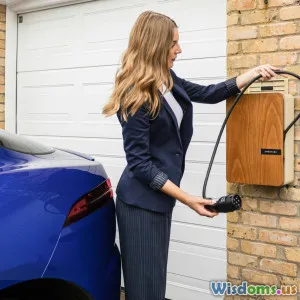
Inside the Race for Faster Car Charging Times Who Is Winning
10 min read Explore the intense global race to cut electric car charging times and discover who's leading the charge. (0 Reviews)
Inside the Race for Faster Car Charging Times: Who Is Winning?
Introduction
Imagine stopping at a charging station during a long road trip and waiting only a few minutes to get your electric vehicle (EV) back on the road with a near-full charge. For years, this prospect seemed like a distant dream, as EV charging traditionally lagged behind the speed of conventional refueling. Yet today, a fierce race is underway among car manufacturers, battery developers, and infrastructure providers to slash charging times dramatically. Why does this matter? Faster charging is pivotal for accelerating EV adoption by addressing one of the biggest consumer pain points: charging convenience.
This article delves into the key players and technologies driving the push for quicker EV charging. From ultra-fast charging stations hitting the market to advances in battery chemistry and management, we investigate who is winning the race and what the future holds for drivers and the automotive industry at large.
Understanding the Challenge: Why Speed Matters in EV Charging
Unlike gasoline cars, which refill in minutes, EVs rely on electrical energy replenishment that historically takes much longer. A standard Level 2 charger might take 6–12 hours for a full charge, which is unrealistic for everyday refueling needs.
The introduction of DC fast charging stations—typically rated between 50 kW and 150 kW—helped reduce charging times to roughly 30 minutes or less. Yet, 30 minutes is still considerably longer than a 5-minute gasoline pump stop.
The challenge is multifaceted:
- Battery chemistry and thermal limits: Charging too fast can degrade battery health.
- Infrastructure constraints: Electrical grids and charging points need to handle high-power loads.
- Vehicle compatibility and standardization: Different EVs support varied charging protocols and power levels.
Ensuring rapid, safe, and affordable charging requires breakthroughs on multiple fronts—from battery design to network deployment.
Pioneers in Ultrafast Charging Technology
Tesla Supercharger V3: Setting a Lightning Pace
Tesla pioneered widespread fast charging with its Supercharger network. The latest V3 Superchargers deliver up to 250 kW of power, enabling the Tesla Model 3 Long Range to add approximately 75 miles of range in just 5 minutes.
Tesla’s proprietary battery management system supports these rapid rates while mitigating degradation risks. Furthermore, their integrated software intelligently moderates charging curves for optimal speed depending on battery state and temperature.
Electrify America: Expanding High-Power Fast Charging
Electrify America, backed by Volkswagen Group, is aggressively building a network of chargers reaching 350 kW. This capability powers compatible EVs—such as the Hyundai Ioniq 5 and Porsche Taycan—allowing them to replenish 80% of their batteries in roughly 15-20 minutes.
For instance, the Porsche Taycan’s 800-volt system can accept very high charging rates, a leap forward from the typical 400-volt systems, thereby reducing heat generation and enabling higher power input.
Ionity: European Collaboration for High-Speed Charging
Formed by a consortium of automakers including BMW, Ford, Mercedes-Benz, and Volkswagen, Ionity focuses on installing 350 kW fast chargers across Europe. Tailored for long-distance travel, Ionity stations reduce charging stops from an hour or more to under 30 minutes.
This collaboration exemplifies the push for standardized infrastructure supporting cross-brand EV compatibility.
Battery Innovations Enabling Faster Charging
Solid-State Batteries: The Next Frontier
One of the biggest bottlenecks to rapid charging is thermal management and ion exchange dynamics within liquid electrolyte lithium-ion batteries. Solid-state batteries (SSBs) replace liquid electrolytes with solid materials, offering higher resistance to heat and faster charging potentials.
Companies such as QuantumScape and Toyota have made significant strides:
- QuantumScape reported an SSB prototype able to charge to 80% in 15 minutes, maintaining stable cycles beyond 400 miles range.
- Toyota plans to commercialize SSBs by the mid-2020s, touting improved safety and charging speed.
Though still in late-stage development, they represent a game-changer that could cut charging times drastically.
Advanced Battery Management Systems (BMS)
Enhanced software algorithms play a crucial role in managing charge rates to safely optimize speed without battery damage. Tesla’s on-board BMS, for example, balances thermal loads and cell balancing dynamically to maximize ultrafast charging performance.
Legacy automakers are following suit by integrating AI-driven BMS to improve charge curve optimization.
Increasing Battery Voltages
Higher-voltage battery architectures (e.g., 800V systems) reduce current for the same power level, minimizing heat and losses, thus enabling faster and safer charging.
EVs like the Hyundai Ioniq 5, Kia EV6, and Porsche Taycan adopted this approach, showcasing charging times as fast as 18 minutes to 80% capacity.
Infrastructure and Grid Considerations
No matter how advanced the vehicle batteries become, ultrafast charging demands equally capable and abundant charging infrastructure.
Power Supply and Grid Support
Charging stations capable of 350 kW draw immense power — equal to multiple households at once. This necessitates robust grid infrastructure and sometimes dedicated substations.
Utilities in California and Europe are actively upgrading grid capabilities alongside installing energy storage and solar arrays to support demand spikes.
Network Expansion and Accessibility
Companies like EVgo, Shell Recharge, and BP Pulse aim to blanket cities and highways globally with fast chargers. The cumulative effect ensures EV drivers have convenient access, eliminating 'range anxiety' and wait times.
API integration allows app-based charging reservation systems, reducing queue times at popular stations.
Who Is Winning the Race?
Leaders in Charging Speed and Technology
- Tesla holds a considerable edge thanks to its integrated Supercharger network and proprietary tech, making it the most efficient public network.
- Volkswagen Group through Electrify America offers one of the fastest third-party charging ecosystems with broad compatibility.
- Ionity represents a successful pan-European approach, drastically improving accessibility and speed.
Innovations on the Horizon
Solid-state batteries could disrupt the market by offering ultra-rapid charging combined with enhanced range and longevity.
Automakers investing heavily in research and partnerships signal an accelerating timeline for breakthroughs.
Conclusion: The Road Ahead
The race for faster car charging times is more than a contest of speed; it encapsulates the future of mobility. By overcoming current limitations through technological innovation and infrastructure buildup, EVs will become indistinguishable from gasoline vehicles in convenience. Consumers stand to benefit from drastically reduced charging times, broad station networks, and improved battery technologies.
Companies like Tesla, Volkswagen Group, and innovative startups are actively pushing progress, but it is a collective effort across industries and governments that will shape the rapid-charging landscape.
For savvy drivers, staying informed on emerging charging technologies can influence purchasing decisions and travel habits. For the global community, the faster adoption of EVs powered by these charging advances means cleaner air, reduced carbon emissions, and a significant step toward sustainable transportation.
Ultimately, the victor in the race for faster charging will be the consumers who will soon enjoy seamless, quick, and reliable EV charging, transforming how we drive forever.
References:
- Tesla Supercharger Specs, Tesla Official Website
- Electrify America Charging Network Data, Electrify America
- QuantumScape Solid-State Battery Announcements, Company Reports 2023
- Ionity Network Expansion, AutoTech News
- Porsche Taycan Charging Review, Car and Driver
- Hyundai Ioniq 5 Battery Architecture, Hyundai Press Release
- Industry Grid Upgrade Initiatives, UtilityWire
Rate the Post
User Reviews
Popular Posts


















